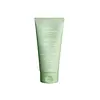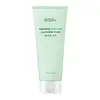What's inside
What's inside
 Key Ingredients
Key Ingredients

 Benefits
Benefits

 Concerns
Concerns

 Ingredients Side-by-side
Ingredients Side-by-side

Water
Skin ConditioningSodium Cocoyl Isethionate
CleansingGlycerin
HumectantHouttuynia Cordata Extract
Skin ConditioningCoco-Betaine
CleansingSodium Methyl Cocoyl Taurate
CleansingButylene Glycol
HumectantGaultheria Procumbens Leaf Extract
PerfumingCentella Asiatica Extract
CleansingGlyceryl Stearate Se
EmulsifyingPotassium Cocoyl Glycinate
Salicylic Acid
MaskingSodium Chloride
MaskingCaprylyl Glycol
EmollientPolyquaternium-67
Tromethamine
BufferingPanthenol
Skin Conditioning1,2-Hexanediol
Skin ConditioningEthylhexylglycerin
Skin ConditioningDisodium EDTA
Water, Sodium Cocoyl Isethionate, Glycerin, Houttuynia Cordata Extract, Coco-Betaine, Sodium Methyl Cocoyl Taurate, Butylene Glycol, Gaultheria Procumbens Leaf Extract, Centella Asiatica Extract, Glyceryl Stearate Se, Potassium Cocoyl Glycinate, Salicylic Acid, Sodium Chloride, Caprylyl Glycol, Polyquaternium-67, Tromethamine, Panthenol, 1,2-Hexanediol, Ethylhexylglycerin, Disodium EDTA
Water
Skin ConditioningCamellia Sinensis Leaf Water 10%
MaskingDisodium Cocoamphodiacetate
CleansingSodium Cocoyl Alaninate
Sodium Methyl Cocoyl Taurate
CleansingAcrylates/C10-30 Alkyl Acrylate Crosspolymer
Emulsion StabilisingSodium Chloride
MaskingGlycerin
HumectantMethylpropanediol
SolventDisodium 2-Sulfolaurate
CleansingCamellia Sinensis Leaf Extract 0.1%
AntimicrobialLactobacillus/Rye Flour Ferment
Skin ConditioningLactobacillus/Soymilk Ferment Filtrate
Skin ConditioningBacillus/Soybean Ferment Extract
Skin ConditioningCarica Papaya Fruit Extract
Skin ConditioningCitrus Aurantium Bergamia Fruit Oil
MaskingLavandula Angustifolia Oil
MaskingQuillaja Saponaria Bark Extract
CleansingLauryl Hydroxysultaine
Cleansing1,2-Hexanediol
Skin ConditioningCaprylyl Glycol
EmollientCoco-Glucoside
CleansingTromethamine
BufferingSodium Cocoyl Isethionate
CleansingSodium Citrate
BufferingStyrene/Acrylates Copolymer
Hexylene Glycol
EmulsifyingSodium Myristoyl Glutamate
CleansingCitric Acid
BufferingButylene Glycol
HumectantCeramide NP
Skin ConditioningPropanediol
SolventNiacinamide
SmoothingFolic Acid
Skin ConditioningPantothenic Acid
Skin ConditioningPyridoxine
Skin ConditioningThiamine Hcl
MaskingCyanocobalamin
Skin ConditioningRiboflavin
Cosmetic ColorantXanthan Gum
EmulsifyingLimonene
PerfumingLinalool
PerfumingWater, Camellia Sinensis Leaf Water 10%, Disodium Cocoamphodiacetate, Sodium Cocoyl Alaninate, Sodium Methyl Cocoyl Taurate, Acrylates/C10-30 Alkyl Acrylate Crosspolymer, Sodium Chloride, Glycerin, Methylpropanediol, Disodium 2-Sulfolaurate, Camellia Sinensis Leaf Extract 0.1%, Lactobacillus/Rye Flour Ferment, Lactobacillus/Soymilk Ferment Filtrate, Bacillus/Soybean Ferment Extract, Carica Papaya Fruit Extract, Citrus Aurantium Bergamia Fruit Oil, Lavandula Angustifolia Oil, Quillaja Saponaria Bark Extract, Lauryl Hydroxysultaine, 1,2-Hexanediol, Caprylyl Glycol, Coco-Glucoside, Tromethamine, Sodium Cocoyl Isethionate, Sodium Citrate, Styrene/Acrylates Copolymer, Hexylene Glycol, Sodium Myristoyl Glutamate, Citric Acid, Butylene Glycol, Ceramide NP, Propanediol, Niacinamide, Folic Acid, Pantothenic Acid, Pyridoxine, Thiamine Hcl, Cyanocobalamin, Riboflavin, Xanthan Gum, Limonene, Linalool
 Reviews
Reviews

Ingredients Explained
These ingredients are found in both products.
Ingredients higher up in an ingredient list are typically present in a larger amount.
1,2-Hexanediol is a synthetic liquid and another multi-functional powerhouse.
It is a:
- Humectant, drawing moisture into the skin
- Emollient, helping to soften skin
- Solvent, dispersing and stabilizing formulas
- Preservative booster, enhancing the antimicrobial activity of other preservatives
Butylene Glycol (or BG) is used within cosmetic products for a few different reasons:
Overall, Butylene Glycol is a safe and well-rounded ingredient that works well with other ingredients.
Though this ingredient works well with most skin types, some people with sensitive skin may experience a reaction such as allergic rashes, closed comedones, or itchiness.
Learn more about Butylene GlycolCaprylyl Glycol is a humectant and emollient, meaning it attracts and preserves moisture.
It is a common ingredient in many products, especially those designed to hydrate skin. The primary benefits are retaining moisture, skin softening, and promoting a healthy skin barrier.
Though Caprylyl Glycol is an alcohol derived from fatty acids, it is not the kind that can dry out skin.
This ingredient is also used as a preservative to extend the life of products. It has slight antimicrobial properties.
Learn more about Caprylyl GlycolGlycerin is already naturally found in your skin. It helps moisturize and protect your skin.
A study from 2016 found glycerin to be more effective as a humectant than AHAs and hyaluronic acid.
As a humectant, it helps the skin stay hydrated by pulling moisture to your skin. The low molecular weight of glycerin allows it to pull moisture into the deeper layers of your skin.
Hydrated skin improves your skin barrier; Your skin barrier helps protect against irritants and bacteria.
Glycerin has also been found to have antimicrobial and antiviral properties. Due to these properties, glycerin is often used in wound and burn treatments.
In cosmetics, glycerin is usually derived from plants such as soybean or palm. However, it can also be sourced from animals, such as tallow or animal fat.
This ingredient is organic, colorless, odorless, and non-toxic.
Glycerin is the name for this ingredient in American English. British English uses Glycerol/Glycerine.
Learn more about GlycerinChances are, you eat sodium chloride every day. Sodium Chloride is also known as table salt.
This ingredient has many purposes in skincare: thickener, emulsifier, and exfoliator.
You'll most likely find this ingredient in cleansers where it is used to create a gel-like texture. As an emulsifier, it also prevents ingredients from separating.
There is much debate on whether this ingredient is comedogenic. The short answer - comedogenic ratings don't tell the whole story. Learn more about comegodenic ratings here.
The concensus about this ingredient causing acne seems to be divided. Research is needed to understand if this ingredient does cause acne.
Scrubs may use salt as the primary exfoliating ingredient.
Learn more about Sodium ChlorideSodium cocoyl isethionate is a natural ingredient from coconut oil. It is an ultra gentle cleanser that gives a nice foam without drying the skin or impacting the skin barrier.
The amount of foam created depends on the amount of sodium cocoyl isethionate used in the product.
This ingredient also helps improve the spreadability of a product.
Learn more about Sodium Cocoyl IsethionateThis gentle cleansing and foaming ingredient is known for leaving a smooth feeling in skin and hair. It is made using coconut oil.
According to the manufacturer, it is soluble in water and has resistance to hard water, acid, and alkali.
Due to its coconut base, it may not be Malassezia folliculitis safe.
Learn more about Sodium Methyl Cocoyl TaurateTromethamine helps balance the pH and improve the texture of a product. It is synthetically created.
As an emulsifier, Tromethamine prevents oil and water ingredients from separating. This helps stabilize the product and elongate a product's shelf life. Tromethamine also makes a product thicker.
Tromethamine helps balance the pH level of a product. Normal pH level of skin is slightly acidic (~4.75-5.5). The acidity of our skin is maintained by our glands and skin biome. Being slightly acidic allows our skin to create an "acid mantle". This acid mantle is a thin barrier that protects our skin from bacteria and contaminants.
Oral Tromethanmine is an anti-inflammatory drug but plays the role of masking, adding fragrance, and/or balancing pH in skincare.
1,3-Propanediol, 2-amino-2-(hydroxymethyl)-
Learn more about TromethamineWater. It's the most common cosmetic ingredient of all. You'll usually see it at the top of ingredient lists, meaning that it makes up the largest part of the product.
So why is it so popular? Water most often acts as a solvent - this means that it helps dissolve other ingredients into the formulation.
You'll also recognize water as that liquid we all need to stay alive. If you see this, drink a glass of water. Stay hydrated!
Learn more about Water